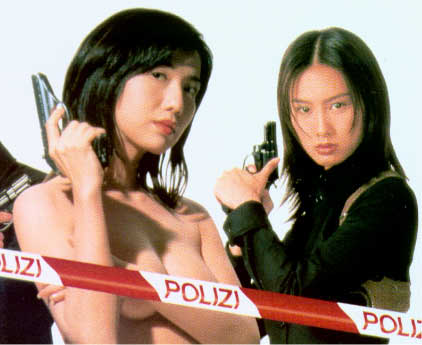VII. Pragmatic Reading

Closing Remarks
If, as seems likely, the very category “fan”
is itself constructed by the act(s) of viewing (“reading”) multiple texts,
it is likely that other aspects of viewership – including the readings
actually negotiated – will also depend on experience. Varying from
viewer to viewer, such experience may include not only matters of culture,
gender and ideology, but also familiarity with intertextual matters such
as a performer’s martial arts skill or other roles. While films obviously
vary in the ease with which their textually constructed meanings can be
disputed, it has been argued here that HK GWG films offer unusually rich
opportunities for readings from a variety of ideological and identificatory
perspectives. Such opportunities, and the pleasures accompanying
them, may be enhanced by awareness of those principles and conventions
of narrative cinema concerning gender that these films sometimes foreground,
as well as intertextual knowledge of the performers, culture and symbolism.
These factors all combine to produce viewing pleasure.
 Linda Williams’ characterization of genre films
that foreground emotional excess as “non-linear spectacles” (Note
5) suggests that they may ultimately resist
linear attempts at classification and, above all, explanation. Salient
images such as Cynthia Khan’s machine gun toting bride (“Queen’s High”),
Michelle Yeoh’s motorcycle jump onto a moving train (“Supercop”) or Michiko
Nishiwaki’s spectacular musculature (e.g., “My Lucky Stars”) resonate at
a primal, emotional level. Within the context of gender role, perhaps
such elements function as “strange attractors” (Note
6) serving to destabilize and collapse conventional
meanings. Cine-psychoanalysis may be correct in pointing to the significance
of boundary violations and threats to the traditional symbolic order, while
being wrong about the underlying theoretical explanation. The spectatorial
experience seems as have as much to do with the thrill of chaos and disruption
as with an orderly process of gendered identification. GWG films
seem to poke a thumb in the eye of many traditions. The conflation
of raw sensation seeking with role violations amplifies the chaos by which
the pleasure of familiar genre imagery is literally “made strange” by gender
(Note
7). In responding to these films’ assault
on gendered conventions, occasionally alternative sexuality and intercultural
appeal, a sub-culture of Western spectatorship may actually become aligned
with the oppositional stance articulated by “queer theory” (Note
8).
Linda Williams’ characterization of genre films
that foreground emotional excess as “non-linear spectacles” (Note
5) suggests that they may ultimately resist
linear attempts at classification and, above all, explanation. Salient
images such as Cynthia Khan’s machine gun toting bride (“Queen’s High”),
Michelle Yeoh’s motorcycle jump onto a moving train (“Supercop”) or Michiko
Nishiwaki’s spectacular musculature (e.g., “My Lucky Stars”) resonate at
a primal, emotional level. Within the context of gender role, perhaps
such elements function as “strange attractors” (Note
6) serving to destabilize and collapse conventional
meanings. Cine-psychoanalysis may be correct in pointing to the significance
of boundary violations and threats to the traditional symbolic order, while
being wrong about the underlying theoretical explanation. The spectatorial
experience seems as have as much to do with the thrill of chaos and disruption
as with an orderly process of gendered identification. GWG films
seem to poke a thumb in the eye of many traditions. The conflation
of raw sensation seeking with role violations amplifies the chaos by which
the pleasure of familiar genre imagery is literally “made strange” by gender
(Note
7). In responding to these films’ assault
on gendered conventions, occasionally alternative sexuality and intercultural
appeal, a sub-culture of Western spectatorship may actually become aligned
with the oppositional stance articulated by “queer theory” (Note
8).
 Many Western fans of HK cinema doubtless report
they were initially drawn to it by the search for something “different.”
For those who enjoy GWG films, this essay may help explicate the source
of that difference either in the opportunity for contact with a counter-aesthetic
to patriarchy that some of these films provide, or perhaps in the sheer
scopophilic pleasure of watching cinema’s most impressive Final Girls.
Many Western fans of HK cinema doubtless report
they were initially drawn to it by the search for something “different.”
For those who enjoy GWG films, this essay may help explicate the source
of that difference either in the opportunity for contact with a counter-aesthetic
to patriarchy that some of these films provide, or perhaps in the sheer
scopophilic pleasure of watching cinema’s most impressive Final Girls.
Notes: Pragmatic Reading
5. Williams, op. cit., esp. pp. 268 – 269.
6. Ann Marie Barry, Visual Intelligence:
Perception, Image, and Manipulation in Visual Communication. Albany:
State University of New York Press, 1997, p. 71, p, 100.
7. Charlotte Brunsdon, “Men’s genres for women.”
In, Baehr & Dyer (Eds.), op. cit., pp. 184 – 202, esp. p. 188.
8. See Alexander Doty, “Queer theory.”
In, Hill & Gibson (Eds.), op. cit., pp. 146 – 150.



